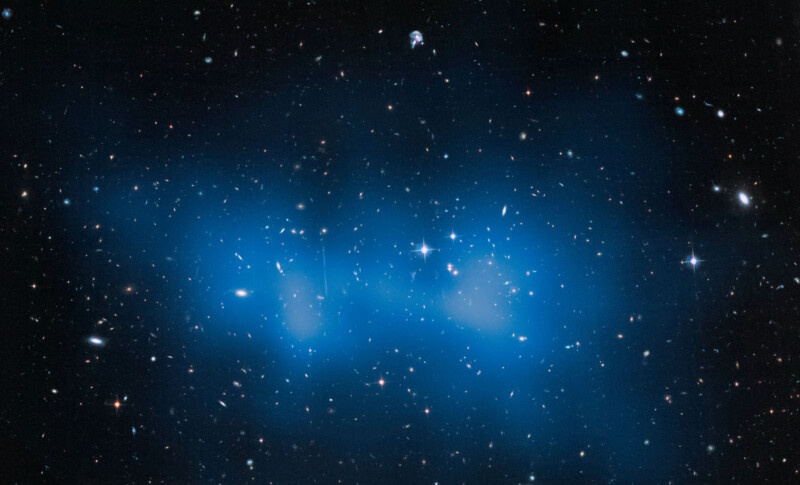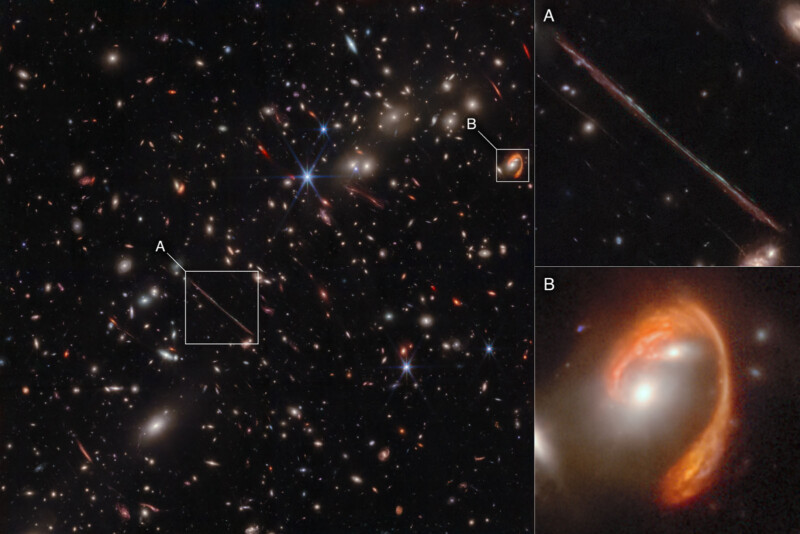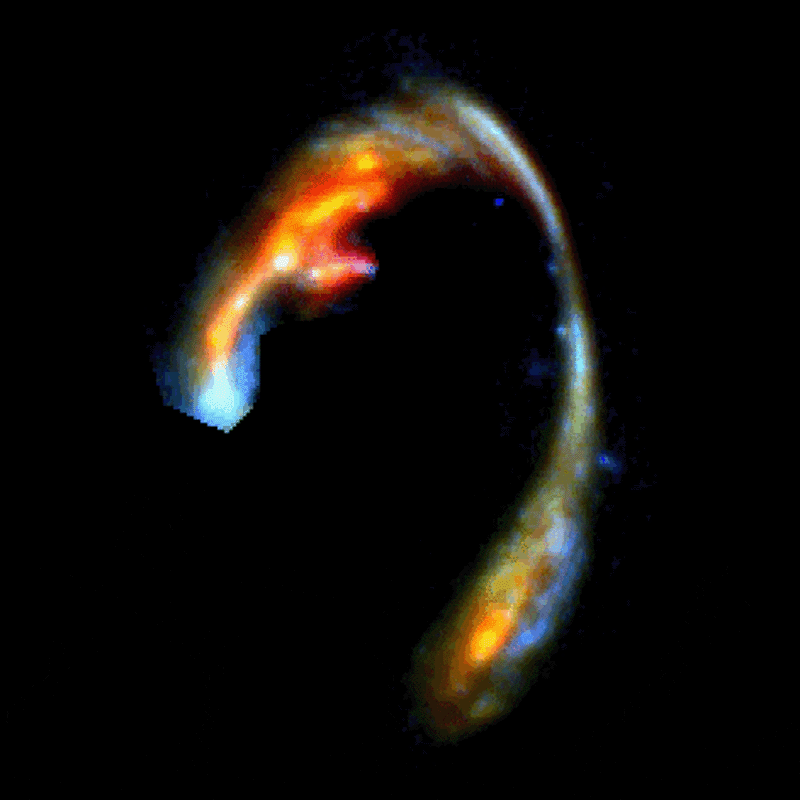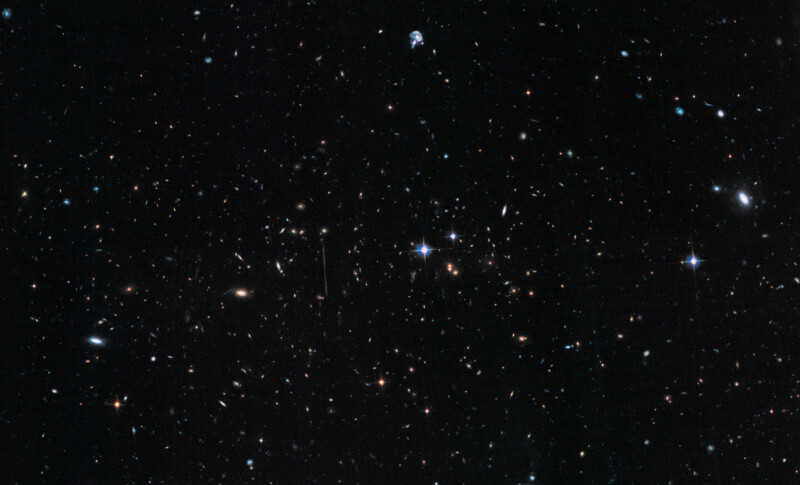Webb Unveils Strange Distant Galaxies in Incredible New Detail

Webb’s new infrared image of the galaxy cluster “El Gordo” (“the Fat One”) showcases hundreds of galaxies, some of which have never been seen before in such detail. Using its Near-Infrared Camera (NIRCam), Webb has used the gravitational lensing created by El Gordo to see distant background galaxies more clearly, offering scientists a unique look at the distant universe.
Gravitational lensing is when a massive object, such as a galaxy cluster like El Gordo, magnifies or distorts the light of objects behind it. The gravitational field of an object such as El Gordo bends the light rays of distant galaxies as they travel by, which can make otherwise impossible to see objects visible to powerful space telescopes like Webb.

El Gordo is a cluster of hundreds of galaxies that scientists believe existed when the universe was just 6.2 billion years old, which NASA says makes El Gordo a “cosmic teenager.” It is the most massive cluster known to exist at this time in the universe’s evolution.
“Lensing by El Gordo boosts the brightness and magnifies the sizes of distant galaxies. This lensing effect provides a unique window into the distant universe,” says Brenda Frye of the University of Arizona. Frye is co-lead of the PEARLS-Clusters branch of the Prime Extragalactic Areas for Reionization and Lensing Science (PEARLS) team and the lead author on one of four papers that analyze Webb’s new El Gordo observations.
Alyssa Pagan processed the new Webb image from the Space Science Telescope Institute (STScI). In PetaPixel’s recent interview with Pagan and fellow image processor Joe DePasquale, also of STScI, Pagan described that she and DePasquale work closely with scientists to ensure that Webb’s visuals do a good job reflecting the scientific work in a visually compelling way.
Since there are four journals about Webb’s data on El Gordo, Pagan and the rest of STScI’s public outreach team met with many more scientists than usual to work on the image.
“We had a meeting with many scientists (some were brought in later in the process and weren’t part of the initial meeting) and shared the image with all of them for feedback,” Pagan tells PetaPixel.
“There are logistics that make this type of release a bit more difficult in terms of communication and waiting for all the papers to be published before making the release public; so ultimately, it functions the same, but with more moving parts,” Pagan continues.
El Gordo’s Striking Features
El Anzuelo
Within the new image of El Gordo are numerous interesting features, including a bright arc in the upper right area. Nicknamed “El Anzuelo,” Spanish for “The Fishhook,” by one of Frye’s students.
The light from El Anzuelo took 10.6 billion years to reach Earth. “Its distinctive red color is due to a combination of reddening from dust within the galaxy itself and cosmological redshift due to its extreme distance,” NASA explains.
Since El Anzuelo is affected by gravitational lensing caused by El Gordo, scientists must correct for that to analyze and measure the background galaxy properly. El Anzuelo is only 26,000 light-years in diameter, which is about a quarter the size of the Milky Way. Scientists also learned that El Anzuelo is in the midst of “quenching,” which is when star formation is rapidly declining in a galaxy’s center.
“We were able to carefully dissect the shroud of dust that envelops the galaxy center where stars are actively forming,” says Patrick Kamieneski of Arizona State University, lead author on a second paper. “Now, with Webb, we can peer through this thick curtain of dust with ease, allowing us to see firsthand the assembly of galaxies from the inside out.”

La Flaca
Another prominent feature in the Webb image is a long, thin line at the left of center. Known as “La Flaca,” or (“the Thin One”), it is a background galaxy affected by El Gordo’s gravitational field. The light from La Flaca takes nearly 11 billion years to reach Earth.
Near La Flaca is another lensed galaxy. Researchers looked closer at it and found a single red giant star. Nicknamed Quylurr, the Quechua term for star, the red giant is the first individual red giant observed more than one billion light-years from Earth.
Stars at high redshift like this are only detectable using infrared filters and thanks to Webb’s groundbreaking sensitivity. Hubble has found lensed stars before, such as Earendel, but they are all blue supergiants.
“It’s almost impossible to see lensed red giant stars unless you go into the infrared. This is the first one we’ve found with Webb, but we expect there will be many more to come,” remarks Jose Diego of the Instituto de Física de Cantabria in Spain, the lead author of a third paper on El Gordo.

Webb Spies a Newborn Galaxy
“Other objects within the Webb image, while less prominent, are equally interesting scientifically. For example, Frye and her team (which includes nine students from high school to graduate students) identified five multiply lensed galaxies which appear to be a baby galaxy cluster forming about 12.1 billion years ago. There are another dozen candidate galaxies which may also be part of this distant cluster,” NASA explains.
Additional data are required to confirm the members of the observed cluster, but Frye thinks the team may be looking at a new galaxy cluster “forming right before our eyes, just over a billion years after the big bang.”

A fourth paper on El Gordo examines ultra-diffuse galaxies, which are “very faint, smudge-like galaxies.” The galaxies are scattered throughout the El Gordo image and their stars are widely spread out.
The team identified some of the most distant ultra-diffuse galaxies ever observed.
“We examined whether the properties of these galaxies are any different than the ultra-diffuse galaxies we see in the local universe, and we do actually see some differences. In particular, they are bluer, younger, more extended, and more evenly distributed throughout the cluster. This suggests that living in the cluster environment for the past 6 billion years has had a significant effect on these galaxies,” explains Timothy Carleton of Arizona State University, lead author on the fourth paper.
Unlocking ‘Einstein’s Treasure Chest’ with Webb
“Gravitational lensing was predicted by Albert Einstein more than 100 years ago. In the El Gordo cluster, we see the power of gravitational lensing in action,” concludes Rogier Windhorst of Arizona State University, principal investigator of the PEARLS program. “The PEARLS images of El Gordo are out-of-this-world beautiful. And, they have shown us how Webb can unlock Einstein’s treasure chest.”
Pagan’s Image Processing Approach
Compared to what Hubble saw when it observed El Gordo, Webb goes much further and exposes many more distant background galaxies and cosmic objects in rich detail.

“Luckily, Webb did most of the work in capturing the unique galaxy features like La Flaca and El Anzuelo in unprecedented detail, but I did process the image with highlighting these features as much as possible in mind as well as the fainter background galaxies,” Pagan tells PetaPixel over email.
“This just informs the stretch, which tends to be more aggressive with deep field images as well as the use of deconvolution algorithms to sharpen any features in the lensed galaxies such as magnified reg giants, etc.” she continues.
The “stretch” she refers to is the process of extending the tonal range of an image captured by Webb or other astronomical instruments to bring out all the fine detail that the detectors capture. When Webb images are first downloaded, they are very dark.
They are also monochromatic, so Pagan assigns color channels to the filters used by Webb’s instruments. Each filter captures a specific wavelength range, and using a principle called chromatic ordering, which mimics how human vision works, Pagan applied red, green, and blue filters to Webb’s black and white images. This process brings the universe to life in beautiful, full-color imagery.
Six filters were used to capture the new image of El Gordo, including at wavelengths of 1.15 to 4.44 μm. The shortest wavelengths are assigned to the blue channel, while the longest to the red channel.
“Normally, when dealing with deep fields, we like to stack filters in this way because it helps emphasize the color separation. This is important because color helps inform us of which galaxies are further away (redder) and which are in the foreground (bluer). So it allows us to visually recognize some of the farthest galaxies in the field,” Pagan explains.
Image credits: NASA, ESA, CSA, J. Diego (Instituto de Física de Cantabria), B. Frye (University of Arizona), P. Kamieneski (Arizona State University), T. Carleton (Arizona State University), R. Windhorst (Arizona State University), A. Pagan (STScI), J. Summers (Arizona State University), J. D’Silva (University of Western Australia), A. Koekemoer (STScI), A. Robotham (University of Western Australia)